Method for making marshmallow mastic at home:
- Take a deep glass bowl and place marshmallows in it. Microwave safe dishes can be used.
- Add lemon juice and butter.
- Place in the microwave for a few seconds. The marshmallow should begin to melt, but do not allow it to completely dissolve or boil. As a rule, it takes 25–30 seconds to achieve the desired consistency, but due to different oven power, this process may take longer or faster.
- Remove and stir until smooth.
- Mix starch and powdered sugar.
- Gradually add powder and starch into the mixture, mixing thoroughly each time.
- When the mixture becomes thick and pliable, stops sticking to your hands and begins to shine, wrap it in cling film and place it in the refrigerator for a day.
Advice! When making mastic, always use store-bought powdered sugar. It must be very fine, which cannot be achieved at home. If there are grains of sugar in the powder, the mass will begin to tear.
How to color mastic for making figurines
Before sculpting, you should paint the mastic in the desired colors. To do this, use natural gel dyes. They are very economical, thick and concentrated, making it possible to obtain both bright, saturated colors and delicate warm shades.
To color fondant, separate a small ball of material, make a well in the center and add a little food coloring. Then stir vigorously until the color is uniform. After coloring, each piece must be wrapped in cling film to avoid drying.
You can paint a finished figure with a brush, but in this case You need experience and good artistic abilities. It is important not to paint on different parts of the figure and to be careful.
Making figurines from mastic
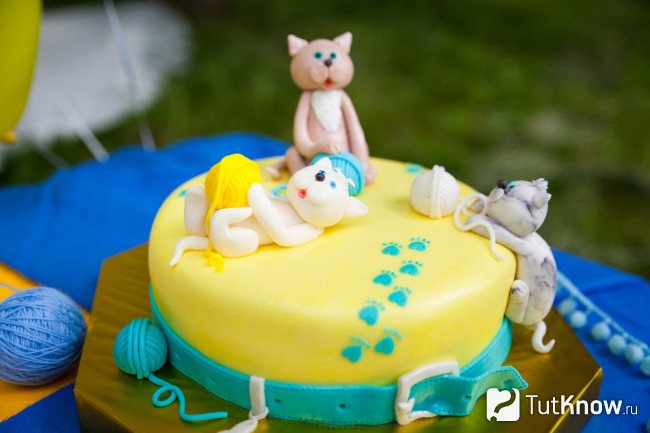
The basic design principle for the figure itself is quite simple:
- If you plan to transport the finished product, it is recommended to make a wire frame that will reliably secure the position and individual parts of the mastic figurine. The frame is also made in the case of a strong inclination of the figure.
- The face of a cartoon character or person can be made using a special mold, or using ordinary dolls with a relief profile.
- Various parts, such as the head and body, are connected using toothpicks or skewer.
- Small details, such as fingers, fringe on clothes, etc., are cut out with a knife or an artistic cutter.
- Patterns on the surface are drawn with a toothpick.
- Details such as eyes, lips, eyelashes, eyebrows, small fragments of clothing are colored with edible markers.
- To add shine to elements or give a natural look, use kandurin. It is diluted in vodka and applied to the figurine with a brush.
Important! During the modeling process, do not remove the main mass from the cling film. Having separated the desired piece from it, immediately wrap the edges of the film so that the mastic does not harden.
How to make flowers from mastic
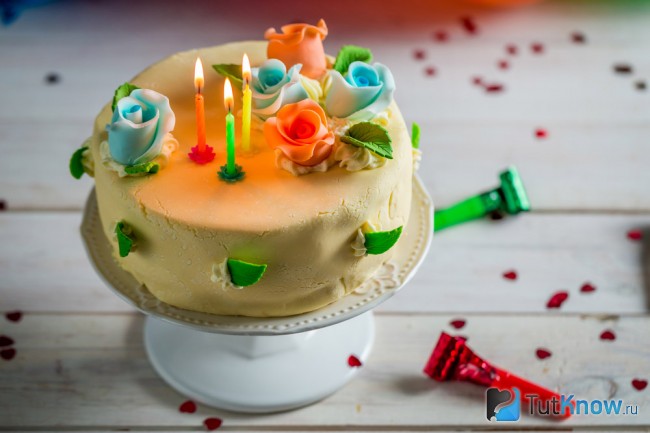
Flowers are the most popular, spectacular and traditional decoration for cakes. Mastic for creating flowers is particularly flexible, since it is rolled out in a very thin layer that should not tear.
Milk mastic recipe for flowers
To create simple compositions You can use a milk recipe:
- Mix sifted powdered sugar, dry milk and condensed milk in equal proportions. Knead until you obtain a homogeneous, thick mass.
- Divide the mixture into several parts and color with food coloring.
- Wrap each part in cling film and place in the refrigerator for a day.
Marshmallow flower mastic recipe

Ingredients:
- Egg white - 1 pc.
- Tragant - 2 teaspoons;
- Sifted powdered sugar - 250 grams.
Method for preparing marshmallow flower mastic for cake:
- Mix the protein, tragacanth and powder until a homogeneous, plastic mass.
- Wrap in cling film and leave for 4 hours.
- Add marshmallow mastic in a proportion of 1/3 to the previously prepared mass, mix thoroughly, wrap in film and leave in the refrigerator for a day.
Advice! To ensure that the mastic rolls out well and does not stick to the equipment, wrap the cutting board with cling film, sprinkle your hands and rolling pin with powdered sugar or starch.
How to form flowers from mastic
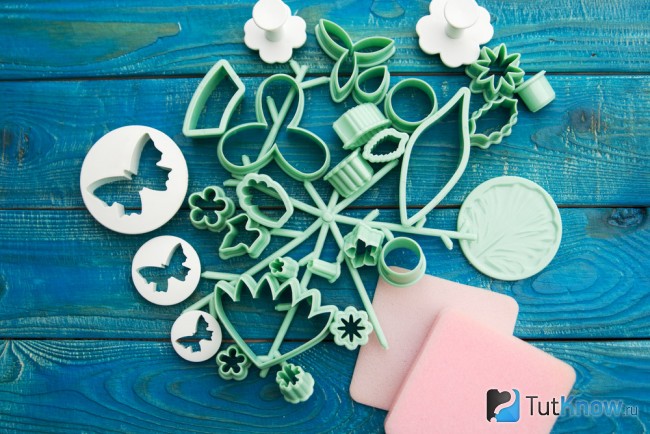
To form beautiful buds you will need: a mastic ball, foam rubber, foil, molds for cutting out flowers and petals, silicone viners, a toothpick.
An example of making a rose from mastic:
- Prepare the core for the flower - form an elongated circle in the shape of a drop and leave to dry for 2 hours.
- Roll out mastic pancakes in a thin layer, cut out a flower with a mold. Use a ball along the edges of the leaves to give them a natural, curved shape.
- Place the core on one edge of the toothpick.
- Place the cut out flower on a foam stand and pierce the center with a toothpick so that the core falls onto the petals.
- Fold the petals onto the core in the following sequence: 1, 3, 5, 2, 4. This will make the rose look more natural. Leave the workpiece for 10 minutes.
- Make the next layers three-leafed, i.e. remove the 2nd and 4th petals. The procedure for applying to the workpiece is the same as in the previous paragraph.
- Repeat this manipulation with the remaining layers until you achieve the desired thickness of the bud.
- The flower is dried with the head down.
Special cuttings will help you achieve the desired shape of the petals and leaves; you can make veins with a weiner or a toothpick. You can buy special confectionery equipment that includes everything necessary tools to give shape and pattern.
If you don’t have time for complex manipulations, use a 2D mold. Mastic is placed in the mold different colors, placed in the freezer for 5 minutes, then the finished flower is carefully removed from the mold.
Dry the fondant decorations well at room temperature and attach them to the cake just before serving. If you secure the flowers in advance and put them in the refrigerator, they will become saturated with moisture and fall off.
DIY pastillage
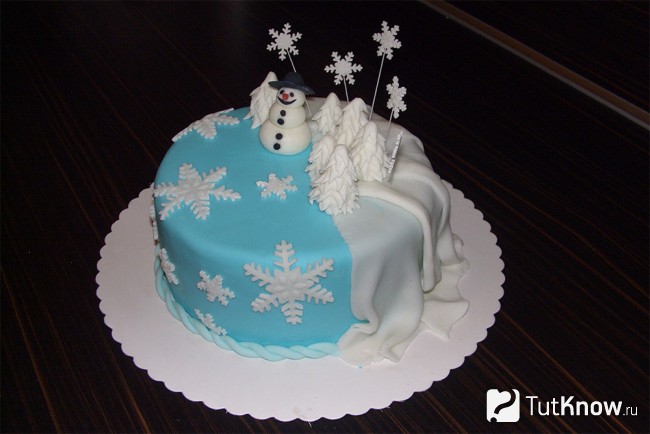
A recipe for mastic with gelatin or pastillage is often used to create complex flowers or figures with miniature elements for decorating a cake. This mass retains its given shape well, is very plastic and hardens quickly. At the same time, gelatin mastic is quite cheap financially, unlike other types.
Making pastillage is not easy. To ensure that the mass has the desired consistency, does not tear when rolling and does not crumble, it is necessary to strictly follow the technology for working with gelatin.
Ingredients for pastillage:
- Gelatin - 25 g;
- Sugar - 2 cups;
- Powdered sugar - 1.2 kg;
- Starch - 300 g;
- Water - 1 glass;
- Maple or corn syrup - 170 g;
- Salt - on the tip of a teaspoon.
- Pour gelatin into 0.5 cups of cold water and leave for several hours.
- Put the gelatin on the fire and hold until the lumps are completely dissolved. Do not bring to a boil, otherwise the product will lose its properties. Strain.
- Mix sugar, syrup, salt and 0.5 cups of water. Bring to a boil, stirring constantly with a whisk. Reduce heat and leave to simmer for 8 minutes. Remove from heat.
- Place the mixer into the hot mixture and begin whisking, slowly adding the gelatin.
- Beat at maximum speed until the total mass increases significantly. The mixture becomes airy, fluffy and white, increasing almost 3 times its original volume. The desired consistency is usually achieved in 10–13 minutes.
- Replace the beater attachments with spiral beaters and continue mixing, gradually adding powdered sugar.
- As a result, you will get a thick snow-white mastic, which you need to cover on top with cling film and leave for a day at room temperature.
- The next day, place the mastic from the bowl onto a cutting board thickly strewn with starch. Knead the mixture, wrap it in film and put it in the refrigerator for a day.
Be sure to sift the flour and strain the gelatin through a fine sieve before using. Undissolved lumps make the mass less elastic, it begins to tear when stretched, and loses its even, homogeneous structure.
How to make mastic for covering a cake
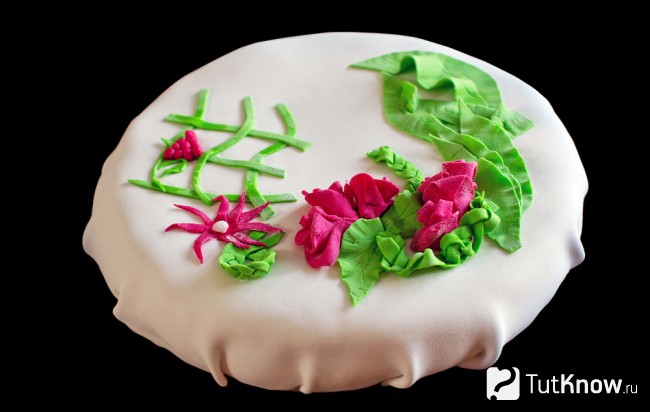
The cake benefits in beauty and taste when completely covered with a delicate and thick paste. Covering the surface of the cakes will not be special labor, if you choose the right mastic recipe.
Sugar mastic recipe
Sugar mastic is suitable for decorating a cake with a single-color filling. It has a very soft texture, rolls out well in a thin layer and is evenly distributed, fitting the cakes. You can also use milk or marshmallow paste.
Ingredients:
- Gelatin - 2 tbsp;
- Powdered sugar - 3 cups;
- Lemon juice - 1 tsp.
- Place instant gelatin in cold water for 40 minutes. Place on the fire and melt until the lumps disappear completely.
- Add powdered sugar and mix thoroughly.
- Add dye if you plan to get a certain color of mastic, mix until you get a uniform tone.
- To make the mixture less cloying, add lemon juice.
- After kneading the paste, wrap it in film and place it in the refrigerator for a day.
Covering the cake is quite simple. The main condition is to level the sides and surface of the product using marzipan paste, ganache, butter cream or condensed milk.
The cake should not be too soaked and its surface should not be wet. Place it in the refrigerator after leveling so that the cream becomes firm.
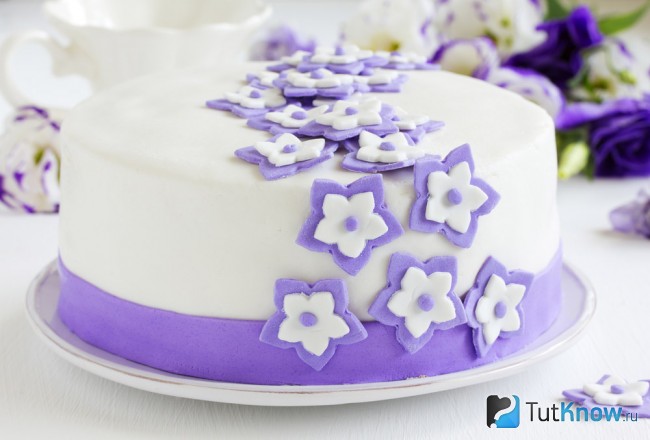
The cake is covered with mastic as follows:
- Place the mastic on a cutting board covered with film, knead it and roll it out with a rolling pin so that the surface is no thinner than 3-4 mm.
- Measure the cake based on its diameter and height. The rolled out mass should cover the entire cake, leaving a margin of 10–15 cm at the edges. This diameter will allow the mastic to lie flat and be evenly distributed over the entire surface.
- Carefully lift the fondant and cover the cake, carefully leveling it over the top layer and sides.
- Trim off the excess pasta at the base with a pizza cutter.
- Level with a spatula.
- If the canvas is torn, you can smooth out the hole with a brush dipped in water.
Mastic, prepared independently, is an original and tasty decoration for home baking. You can completely envelop the cake with it, make beautiful patterns, flowers or personal inscriptions, sculpt figures or create a three-dimensional composition on the product that will delight the craftswoman and surprise the guests.
Other photos:
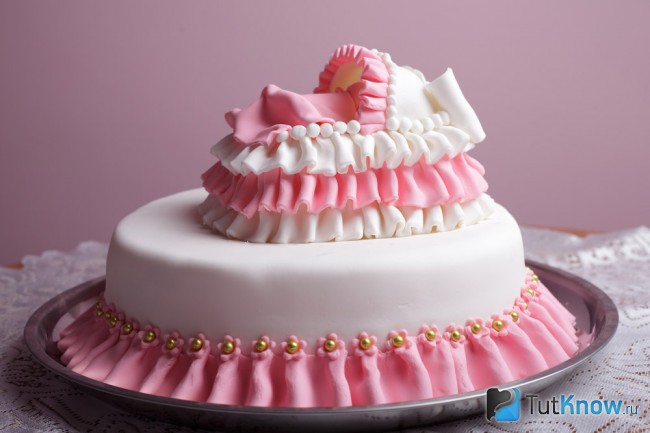
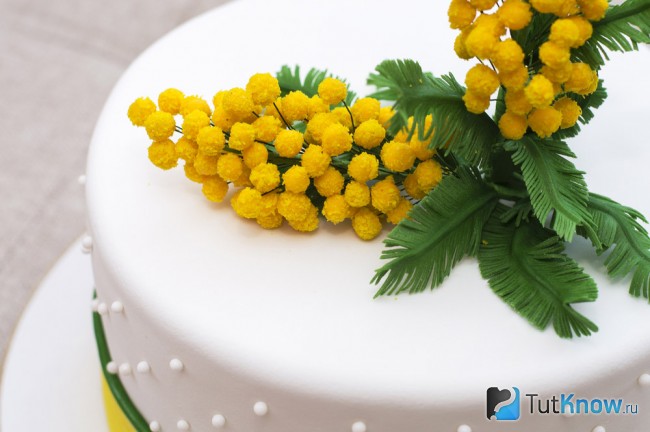
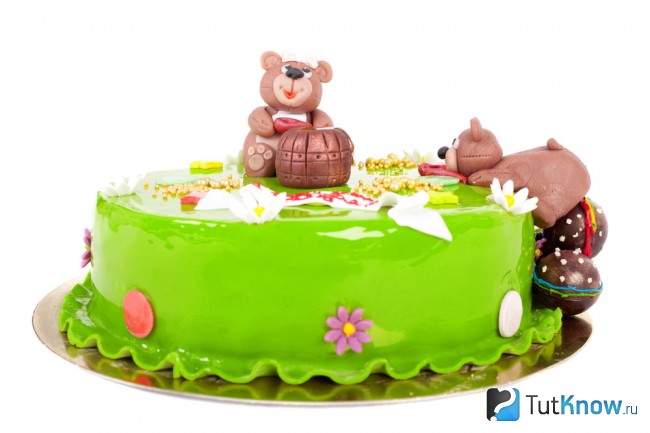
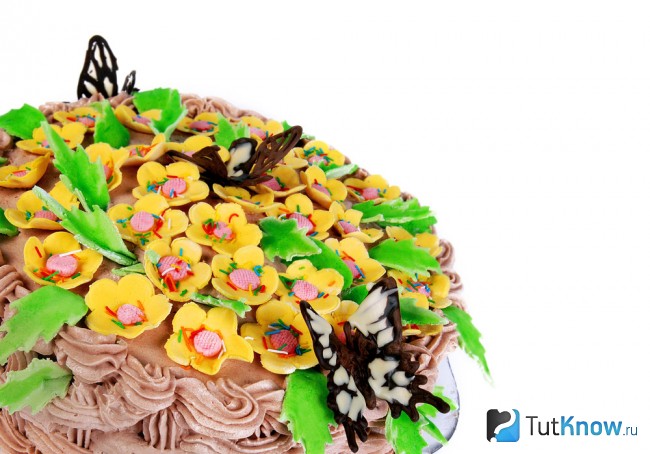
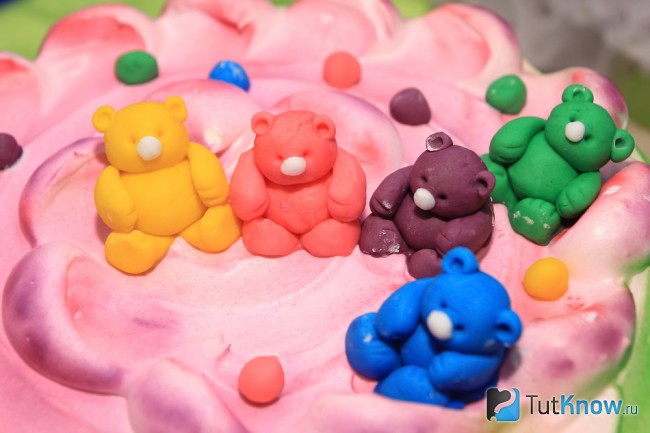

Sugar mastic for cake is a thick plastic cream from which it is easy to make various figures for decorating baked goods. It has a pleasant taste and has a long shelf life. In this article we have collected the most popular mastic recipes - they will be useful for those who always prepare cakes at home: all instructions are illustrated with photographs and step-by-step recommendations, so you will definitely succeed!
Making classic sugar mastic for a cake is not difficult - any non-professional who wants to prepare desserts at home can do it.
We prepare a mixture of the following products:
- Powdered sugar – 455 grams.
- Food grade glycerin – 2 teaspoons.
- Gelatin – 1.5 teaspoons.
- Invert syrup – 1.5 tablespoons.
- Water – 2 tablespoons.
Go to step by step instructions with photo. First, the gelatin is slightly heated in warm water. Then the container is placed in a steam bath, where it is kept for 1–2 minutes. The main thing is not to let the gelatin boil, otherwise it will lose its adhesive properties. Syrup is added to hot gelatin.
Next step: sift the powdered sugar before using. This will protect against lumps that can ruin the appearance.
After the powder has been thoroughly sifted, it must be added to the gelatin mass, then stir everything with your hands. The resulting base can be used immediately (roll it out correctly with a rolling pin, and then apply it to the cake or make figures), or you can leave it for the future. If you properly package and store the mastic at home in the refrigerator, the shelf life of the product can be up to 2 weeks.

If you have mastered the classic recipe, you can make an unusual mastic for the cake, for example, you can make milk, pastillage, custard and chocolate versions with your own hands.
Milk option
For this option the following ingredients are used:
- Dry milk mixture – 150 grams.
- Powdered sugar – 150 grams.
- Condensed milk – 150 grams.
- Lemon juice – 2-3 tablespoons.
Sift the milk powder and powdered sugar well. Then condensed milk is gradually added to this mixture and lemon juice is added. Now knead the mass with your hands until it becomes elastic. To prevent it from sticking to your hands, the table must be constantly sprinkled with powdered sugar or starch. The finished mastic for the condensed milk cake is stored in a container, or roll it into a ball, wrap it in cling film and put it in the refrigerator. Within 2 weeks, the mass can be taken out and used to decorate baked goods.
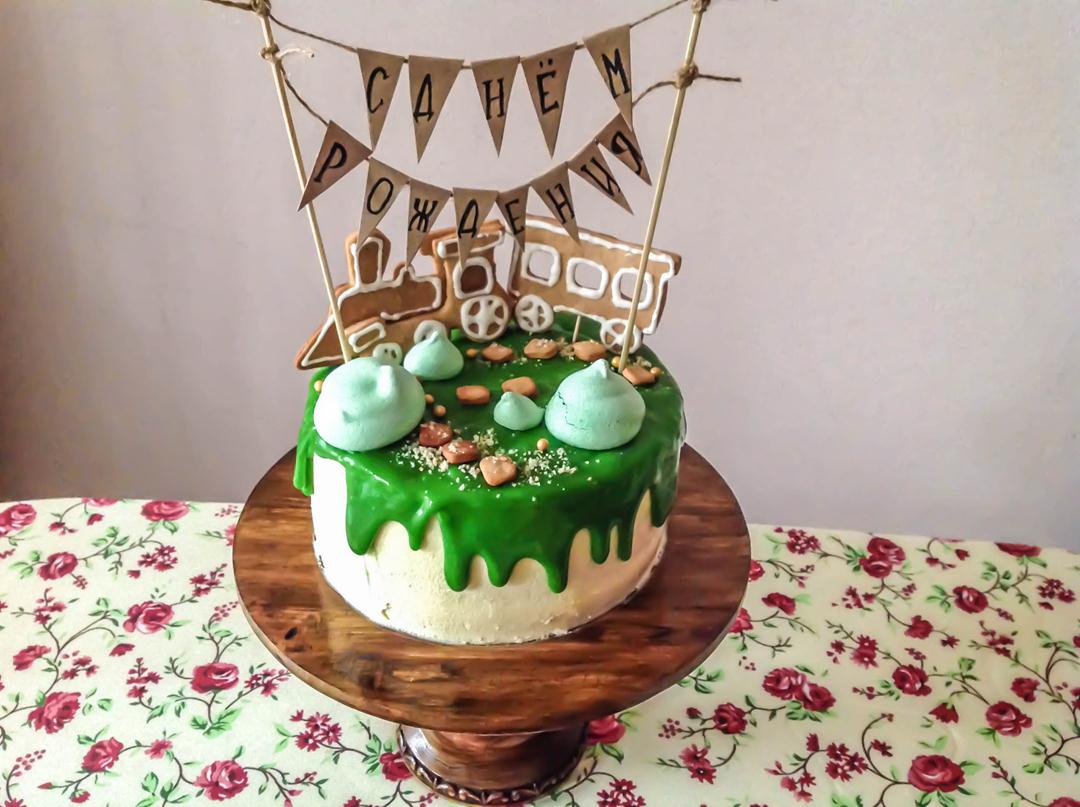
Pastilage
This sugar mastic dries quickly and is convenient for making small parts (for example, it is easy to make a bow, mastic ruffles or edible flower petals from it). Figures made from this mass are durable and can be stored for a long time in a dry room.
For home cooking you will need:
- 0.5 kg of powdered sugar.
- 50 grams of starch.
- 6 grams of gelatin.
- 50 grams of water for wetting.
- A couple of drops of lemon juice and a little honey.
Preparing the mastic takes about 20–30 minutes. First, gelatin is soaked in water with the addition of lemon juice and honey. After everything has swollen, you need to heat the mixture until completely dissolved, and then let it cool. The starch is mixed with powdered sugar, and the dissolved gelatin mass is added there. Everything is whipped with a mixer. If the mass is too thick, then it is better to knead it yourself, with your own hands.
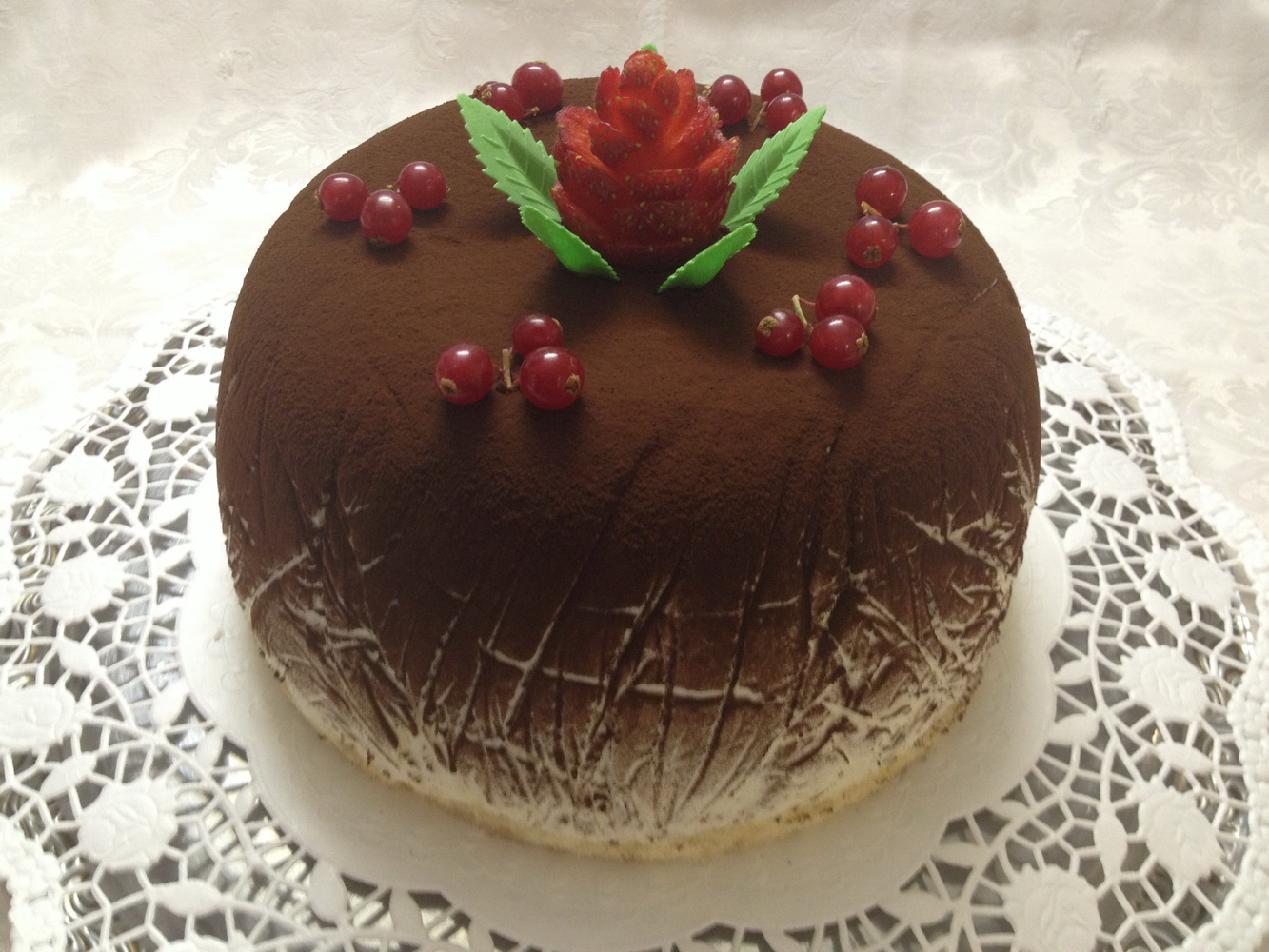
Chocolate marshmallow deliciousness
Mastic for a marshmallow and chocolate cake is convenient because it holds its shape well, does not flow, and does not crumble after the figures dry. And it's also very tasty.
The base is made from the following products:
- Chocolate – 100 grams.
- Small marshmallows – 90 grams.
- Cream – 30 ml.
- Butter – 1 tablespoon.
- Powdered sugar – 120 grams.
- Cognac – 1–2 tablespoons.
Preparation of the mastic mass takes about half an hour. First, carefully dissolve the pieces of sweet chocolate over low heat (the composition does not matter, but milk chocolate will be tastier). We stir it, not allowing it to burn to the bottom of the dish. Without removing from heat, add marshmallows. Cook until completely dissolved. As soon as the marshmallows dissolve, pour the cream, cognac into the pan and add butter. Everything is cooked until a thick, smooth mass is obtained. Remove from heat and add sifted powdered sugar to the hot mixture. Mix until the mixture acquires the consistency of elastic, soft dough, suitable for rolling out and creating the desired shapes.

Custard version
This delicious mastic is prepared from the following ingredients:
- Water - a third of a glass.
- Butter – 50 grams.
- Flour – 100 grams.
- Salt - to taste.
- Cocoa (optional) – 2-3 teaspoons.
- Powdered sugar – 300 grams.
Heat water in a saucepan with oil and a pinch of salt. As soon as the butter melts and the water just begins to boil, add all the flour. If you want to achieve a chocolate taste, then cocoa is added along with flour. After the first bubbles, the saucepan is immediately removed from the heat and powdered sugar is added to the mixture. That's it - the base for decorating the cakes is ready. You can roll it out and apply it to the surface of the cake, or use the rolled out base to make a butterfly, sails or other shapes.
Important Rules
There are some rules and secrets that will help in the production and decoration of your baked goods:
- When preparing a cake with mastic, remember that only dense baked goods will do; the fragile texture will not withstand the decor and will crumble and sag.
- The main ingredient is a base of powdered sugar - without it you won’t be able to make mastic for the cake. It can be made at home by simply grinding and sifting granulated sugar, or you can buy ready-made powder in the store.
- To ensure that the figures retain their shape, professionals at their master classes recommend adding starch, honey, protein mixture, gelatin, marshmallows or condensed milk - these products help to achieve the strength of the mass and prevent crumbling. To glue several figures together, you can use egg white with a little powdered sugar.
- The coating for covering the cake cannot be applied to a damp base - to soaked cakes, to sour cream, etc. The mastic mass quickly dissolves from moisture and loses its thick consistency. It is best to prepare the ganache for the cake and place it in front of the fondant (this will protect the decorations from water). A layer of marzipan is also suitable.
- If you cover the entire surface of the cake with a mastic layer, do it with your hands sprinkled with starch. What you definitely shouldn’t do is pull the edges too hard - the mass may tear. We also recommend rolling out the cake thinner (3–5 mm) - a base that is too thick will not lie flat and will look unsightly.
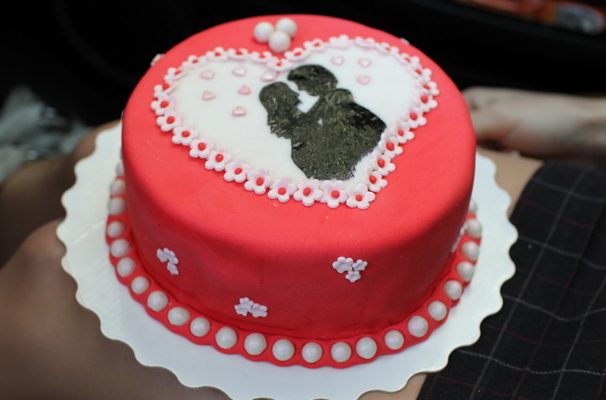
If you want to make colored mastic (for example, get white, red, brown or black mastic), then you are allowed to decorate ready-made figures with food paints diluted with vodka, cognac or liqueur. To make the surface of the cake shiny, cover everything on top with a thin layer of honey and vodka (mixed in a 1:1 ratio).
So, we have listed the basic recipes and talked about the subtleties with which even non-professional cooks can use sugar mastic for coating a cake. Finally, we recommend watching these video tutorials, which clearly show everything we talked about in the article:
Mastic is a special paste that easily takes the desired shape. With its help, even the most ordinary pie can easily be turned into a real culinary masterpiece. Traditionally it comes in gelatin, milk and marshmallow varieties. Let's find out with you how to prepare mastic for a cake in different ways.
Homemade cake mastic recipe
Ingredients:
- instant milk powder – 205 g;
- fine powdered sugar – 215 g;
- condensed whole milk – 155 ml;
- lemon juice – 5 ml.
Preparation
Sift the powder several times and mix with dry natural milk. Carefully pour condensed milk into the dry mixture and add lemon juice. Knead the mastic dense dough, adding a little more powdered sugar if necessary. Homemade mastic for covering a cake should be elastic, homogeneous and not stick to your hands. Now let the delicacy sit in the refrigerator for a while, and then use it to decorate cakes! If you want to give it a bright and rich color, then use food coloring for this.
DIY cake mastic recipe based on marshmallows
Ingredients:
- airy marshmallows “marshmallow” - 105 g;
- white powdered sugar – 235 g;
- lemon juice – 15 ml.
Preparation
Place the marshmallows in a convenient container, pour in lemon juice and heat in the microwave for 45 seconds. During this time, stir the marshmallows several times with a spoon. Gradually add the pre-sifted powdered sugar into the hot elastic mass and knead the dough with your hands until it has the consistency of soft plasticine. After this, we wrap the mastic in a bag and put it in the refrigerator for half an hour, and then use it to model figures and decorate cakes! If you want to make it a bright color, then use any food coloring.
Homemade cake mastic made from gelatin
Ingredients:
- – 535 g;
- dry gelatin – 15 g;
- water – 35 ml;
- lemon juice – 10 ml.
Preparation
Place the dry instant gelatin into a shallow bowl, add a few tablespoons of cold water and mix thoroughly. After 5 minutes, put the dishes on low heat and heat until all the crystals are completely dissolved. Sift the powdered sugar through a sieve several times and gradually pour it into the gelatin mixture in small portions, stirring constantly. Add freshly squeezed lemon juice to the slightly thickened mass. Now we wrap the homemade cake mastic in cling film and leave it to “rest” for a while. Sprinkle the working surface with fine powdered sugar, lay out a lump of mastic and roll it out with a rolling pin. To give it the desired color, you can safely add a few drops of food coloring.
Chocolate mastic for covering a cake at home
Ingredients:
- airy marshmallows - 115 g;
- chocolate – 105 g;
- butter – 10 g;
- heavy cream – 20 ml;
- powdered sugar – 205 g.
Preparation
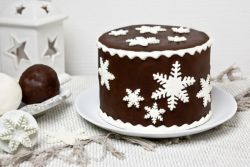
First, melt the chocolate in the microwave or in a water bath. Then add marshmallows and mix. Heat the mass until it increases in volume and mix thoroughly until it becomes viscous. Next, pour in warm cream and add softened butter. Stir the mixture until completely homogeneous and gradually add the sifted powder. Knead the finished mastic with your hands like dough, and it should turn out soft and pliable in the end. Wrap it in film and leave for 45 minutes. You can decorate any cakes with this mastic and sculpt figures from it. If you want to give it a rich brown, then use a little food coloring for this purpose.
Recently, the idea of decorating confectionery products with mastic has been gaining momentum in popularity. It is used to cover both small confectionery products and to decorate huge themed cakes for various celebrations, decorating them additionally with various patterns and figures. The end result is stunningly beautiful confectionery compositions. Of course, for this you need to have at least minimal creative and pastry skills. And if you have all this and all you need is a successful recipe for making mastic, then we recommend using the options for preparing a similar base for decorating a cake, suggested below.
How to make mastic for a cake at home from marshmallows?
Ingredients:
- chewing marshmallow marshmallows – 220 g;
- powdered sugar – 520 g;
- butter – 1 teaspoon.
Preparation
If you need to cover a cake with fondant for a celebration, then fondant made from the well-known chewing marshmallow marshmallow would be ideal for this purpose. It turns out elastic, rolls out perfectly, and tastes pleasant and soft. For this purpose, choose marshmallows of the same color. If you have multi-colored ones, then it is better to divide them into fragments according to color before use.
Place the marshmallows in a suitable container and put them in the microwave for about forty seconds. As a result, the marshmallows should approximately double in volume. Once the desired effect is achieved, add powdered sugar, add a piece of butter and begin stirring the mixture with a spoon. When this is difficult to achieve, dust the table with powdered sugar, spread the mixture on it and finish kneading with your hands. The final texture of the mastic should be uniform and smooth, without any admixture of lumps or air bubbles.
If there is a need to prepare mastic of a certain color, then it is better to add the dye at the very beginning of the batch. If it is dry, then it needs to be diluted in a minimal amount of vodka and only then added to the marshmallow mass.
You can also fill the remaining mastic with color after covering the cake to use it for decorating and sculpting patterns and shapes. For this it is better to use gel dyes. Having added a little color to the lump of mastic, we begin to knead it like plasticine. It will take quite a long time to do this to get an even color, but the result is undoubtedly worth it.
Marshmallow mastic can be perfectly stored in the refrigerator for three months. Before use, you just need to warm it up a little in the microwave and knead lightly, adding powdered sugar.
How to make sugar confectionery mastic at home?
Ingredients:
- – 60 g;
- powdered sugar – 120 g;
- – 120 g;
- lemon juice – 1 teaspoon.
Preparation
To prepare figures and patterns for decorating a cake, it is better to use sugar confectionery mastic. It is more suitable for this purpose. Many people also use it to line cakes, but in this case it is necessary to make it a little softer by increasing the amount of condensed milk so that the finished product rolls out easier and is more flexible.
When starting the preparation process, sift the highest quality natural milk powder into a bowl, add powdered sugar to it, passing it through a sieve, mix and add condensed milk and lemon juice to the dry mixture. We knead the mass first with a spoon, and finish with our hands, achieving a plastic and uniform texture of the coma. Just like in preparing marshmallow mastic, it is better to introduce the dye at the beginning of the kneading, but if necessary, the color scheme can be changed when the mastic is ready, 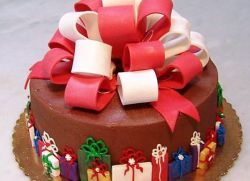 which will significantly prolong the cooking process.
which will significantly prolong the cooking process.
How to make chocolate mastic?
Using any of the proposed recipes as a basis, you can prepare chocolate mastic. To do this, at the beginning of kneading, you need to add about 75 g of melted dark chocolate to the main components. For a richer chocolate flavor, you can also add a couple tablespoons of cocoa powder.
In this case, the consistency of the mastic is controlled by the amount of powdered sugar.
– an ideal material for covering the entire surface of the cake, including the sides, in one layer. It also makes beautiful figures, leaves, flowers, and inscriptions. The material requires a special approach. It dries quickly, and you will need some tools to work with it – irons, a flat rolling pin.
Ingredients:
- Gelatin – 5 teaspoons;
- 3 tablespoons water;
- Fine powdered sugar – 600–700 grams;
- Honey (corn syrup) – 125 milliliters.
Cooking process:
- Soak the gelatin in water and let it sit for at least half an hour.
- When it swells, pour liquid honey over it, mix well and place in a water bath.
- Heat for about 5-10 minutes, stirring regularly until all the gelatin has dissolved.
- Pour the warm mixture into the powdered sugar in a deep bowl. It is advisable to make a small depression in the powder and pour out the honey mixture in a thin stream.
- Mix the mixture first in a bowl and then on a board sprinkled with powder.
- The result should be a soft, plastic, slightly sticky mass.
- Place the ball of sugar mass in a plastic bag and let it rest for about 30 minutes. This time is enough to cover the cake with the material. For figures and flowers, the paste should harden slightly within 24 hours.
- From finished mastic you need to make a thin, uniform layer if you want to cover the cake completely, or sculpt figures.
Sugar and milk mastic

Housewives will really like this version of the paste for covering the cake - the paste turns out to be very pliable, a little softer than ordinary mastic, and is easier to cut with a knife. Using powdered milk allows you to give the finished mastic a white color without dyes.
Ingredients:
- Powdered sugar – 160 grams;
- Powdered milk (or cream) – 160 grams;
- Condensed milk – 200 grams;
- Lemon juice – 3 tablespoons;
- Flavoring – vanilla, cognac or rum essence – 5 milliliters.
Cooking process:
- Sift the powdered sugar twice through the finest sieve.
- Mix it with dry milk directly on the work surface.
- Make a well in the mixture and pour in the condensed milk.
- Knead the dough, add lemon juice and flavoring at the end.
- If the mass is not elastic enough, add dry milk little by little. If liquid - a little boiled water.
- Knead the mixture by hand for at least 15 minutes to ensure there are no lumps. Roll into a ball and wrap in film for half an hour. Roll out the mastic on powdered sugar or milk powder into a thin layer, then wrap your delicious homemade cake.
Mastic on baby formula

If you have any unused baby formula left over, you can also use it to make delicious mastic at home. This baking coating tastes like milk toffee, and is very convenient to work with: it rolls out perfectly, practically does not tear, and does not dry out for a long time. The color of the finished mastic is soft cream.
Ingredients:
- Infant formula – 150 grams;
- Lemon juice – 60 milliliters;
- Condensed milk – 100 grams;
- Powdered sugar – 150 grams.
Cooking process:
- Sift the mixture and powdered sugar through a fine sieve, combine and stir.
- Pour the mixture onto a large board in a heap and make a depression at the top.
- Pour in the lemon juice and condensed milk in a stream. Lemon juice can be taken in smaller quantities.
- Knead the mixture with your hands for 10 minutes, trying to knead it in all directions so that there are no unevenness or lumps.
- We form a ball from the mastic, wrap it in plastic and put it in the refrigerator overnight.
Video gallery
More on the topic:



